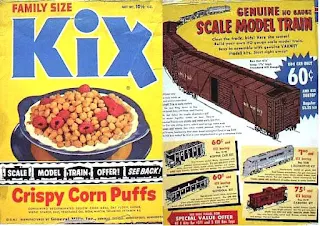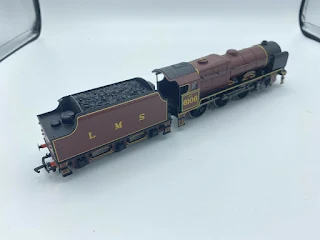As the reader can infer from the title of this post, this author intends to take a diversion from the scope of normal subject matter of this blog. There is a connection, as soon will be revealed, which I hope will prove interesting.
A longtime self-confessed “magpie” or “gallimaufry” (Scottish for bits and pieces) type collector, I consider myself extremely fortunate in my mid-eighties to have somehow avoided being afflicted to date with the model train bacteria. Have to admit that growing up I did have, on loan from my uncle, an early Lionel electric train set which was returned for his children, as my interest in toy soldiers had started. There also was a General Mills Kix Cereal 1947 combination printed on the box and mail-in premiums of cut-out trains which were a popular sales promotional (now having become a collectable antique).
The other singular exception being the more recent collection of a limited number of the Lionel/Hallmark (nominally N gauge - being introduced in 1996) Christmas tree ornaments over the years. Judging from my most recent Internet research it can become highly addictive, and an extreme and continuous drain on the sporran. None the less, I feel it safe to say that model train collectors are an extremely prolific breed, and for quite some time have far outnumbered, and continue to outnumber, toy soldier collectors.
In any event I would be totally less than candid if I did not readily admit to a life-long fascination with small scale toy trains/model railroading, and the engineering precision the hobby incorporates, somewhat analogous to a jeweler or horologist (watchmaker).
However, very recently an opportunity appeared on e-Bay that was too good to pass up. This is obviously a rationalization at best. It was an HO scale locomotive set comprised of the engine, tender, and corridor brake 3rd class coach by Bachmann of a classic LMS “Royal Scot” Class 4-6-0 6P 6100 Series. For those who might not know the letters stand for London, Midlands and Scottish Railway Company. However, more specifically the model I have acquired is Engine 6106 “Gordon Highlander” of the series. 70 actual locomotives were built in the Class, starting in 1927, with the majority being named after regiments of the British Army. Based on my research to date the model was first offered in 1998. Given my family surname, Scottish ancestry, and interest in British/Scottish military history, the reason for my personal interest immediately becomes rather obvious.
A brief segue occurred to the author. Is it merely a coincidence that the distinctive deep maroon livery of the LMS is the same colour originally selected for that of the famous "Red Beret" of the Parachute Regiment of the British Army?
Although several model train manufacturers have produced excellent models of various configurations of the "Royal Scot Class" in various scales, to the best of my knowledge the Bachmann Company is the only one to have produced a "Gordon Highlander" in LMS maroon livery. It was produced in OO gauge. (Author's Note: Both Wrenn and Graham Farish produce a "Gordon Highlander", but neither in the classic LMS maroon livery). In my personal opinion, for an OO scale size, I think they did a great job, but will let the reader be the judge of that, hopefully based on the images presented. The high end connoisseur manufacturer of toy trains, the British Company named Wrenn offer a Royal Scot Class "Gordon Highlander" locomotive in black livery. Wrenn's OO gauge version of the Royal Scot Class in LMS maroon livery is shown, with acknowledgement and gratitude, in the last two images below. One other observation, unlike toy soldiers and military miniatures, model train makers do not take creative artistic license. The exceptions known to the author (there are always exceptions) being the popular "Gordon the Tank Train" series, and the Harry Potter "Hogwarts Express", but neither one passed off as an actual train. As a consequence the models are an extremely accurate replication of exactly the real thing, with the possible exception of the level of detail practically not attainable in some of the physically smaller scales such as N and Z gauge.
The third is the so called former LMS 57 ft Porthole Corridor 1st Class Coach (actually not put in service until 1950) in the next images (model followed by actual coach).
The fourth is a Hornby model of a 68 ft Dining Car (note 6 wheel bogies incorporated for requisite load carrying capacity, comfort and stability) which was introduced into service in 1932 (Running Number 238), and seen here. As both a model and as the real coach, this is a big car (44 tons).
Author’s note: In an attempt to replicate a LMS Stanier 66 ft “QL” (BR “RFO”) First Class Vestibule Diner, of correct vintage, to accompany the previously described LMS 68 ft Dining Car, the closest I could come s a Bachmann 39-476 LMS 60 ft “Porthole” Open Vestibule Coach BR in Maroon livery (obviously later Period III- 1947). The following first image is the correct actual LMS Vestibule Diner, circa 1934, and the second image is a sixth OO gauge Bachmann “equivalent” model.
I have been further advised by experts that my ratio of coaches should be 3:1, Third class to First class. In order to partially rectify this, have acquired an additional LMS 57 ft Corridor Third Class coach (again Period III) to add to the rake, making a total of seven coaches (image follows).
Given the date and composition of this specific rake, the original locomotive number 6106 would be in error, having been rebuilt in September 1949, and renumbered 46106 (see image below).
For those who may not know, the LMS was a massive British railroad monopoly, having been formed on 1 January 1923 under the Railways Act of 1921. Besides being the world's largest transport organisation, it was also the largest commercial enterprise in the British Empire and the United Kingdom's second largest employer, after the British Postal Service. The LMS also claimed to be the largest joint stock organisation in the world.
The “Royal Scot” Class was introduced in 1927, with the “Gordon Highlander” being built in September 1927 (rebuilt 1949), and was in service until being withdrawn in December 1962, with a final short commemorative guest trip in April 1963.
The lead locomotive of the class the "Royal Scot" Engine 6100 was even shipped to the United States in 1933 where it performed a public relations tour including the Chicago World's Fair during the course of its route.
The following images, although not of exactly the same train, are of the Royal Scot Class, intended to provide a direct comparison of the model to the real thing.
The diesel locomotive configuration “Gordon Highlander” is one of 22 British Rail Class 55 engines which were built in 1961 and 1962 by English Electric, which gained the name “Deltic” based on their Napier Deltic power units. The engines were withdrawn from service at the end of 1982, with 6 units preserved and still running today.
https://www.youtube.com/watch?v=yaDdAEDBqio


































